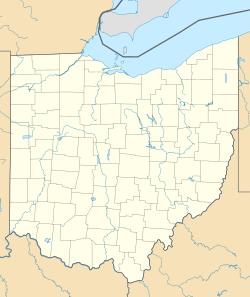
Urbana is a city in and the county seat of Champaign County, Ohio, United States, about 34 miles (55 km) northeast of Dayton and 41 miles (66 km) west of Columbus. The population was 11,115 at the 2020 census. It is the principal city of the Urbana micropolitan area. Urbana was laid out in 1805, and for a time in 1812 was the headquarters of the Northwestern army during the War of 1812. It is the burial place of the explorer and soldier Simon Kenton. The city was home to Urbana University and Curry Normal and Industrial Institute, a school for African American students.

Urbana University was a private university specializing in liberal arts education and located in Urbana, Ohio. In its final few years, it was purchased by Franklin University and was a branch campus of that university.

The George Hummel House is a historic residence in the city of Cincinnati, Ohio, United States. Constructed in the early 1890s, it is built with numerous prominent components from different architectural styles, and it has been named a historic site.
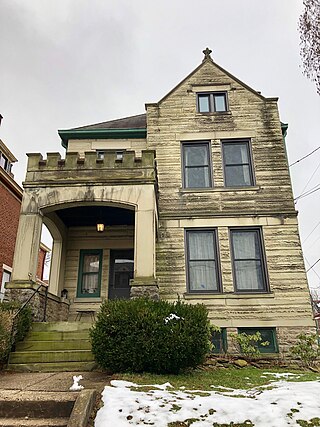
The Charles A. Miller House is a historic residence in Cincinnati, Ohio, United States. Built in 1890 according to a design by Samuel Hannaford, it is a two-and-a-half story building constructed in the Gothic Revival style. A brick and limestone structure with a slate roof, its facade is dominated by courses of ashlar, plus battlements at the top, and a prominent portico at the entrance. The floor plan is that of a rectangle, two bays wide and four bays deep; the right portion of the building features a gable, while the battlements appear primarily on the left side. Structurally, the house is supported by a post and lintel construction, with the exterior courses of stones forming the lintels as well as horizontal bands around the building.

John Vaughan House is a historic house near Shandon, Ohio.

St. Michael's Catholic Church is a historic Catholic church in Mechanicsburg, a village in Champaign County, Ohio, United States. Completed in the 1880s, it served a group of Catholics who had already been meeting together for nearly thirty years. One of several historic churches in the village, it has been designated a historic site because of its well-preserved nineteenth-century architecture.

St. Paul's African Methodist Episcopal Church is a historic church in Urbana, Ohio, United States. Built in the Greek Revival style in 1876, it is home to a congregation that was founded in the mid-1820s.
John Ward House may refer to:
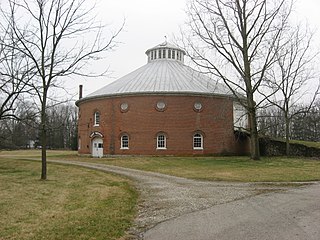
Nutwood Place is a historic farm complex on the northern edge of Urbana, Ohio, United States. Today composed of the farmhouse, a round barn, and a small amount of former fields, the farm has been owned by some of Urbana's leading families. Colonel William Ward, the founder of Urbana and the farm's original owner, built the farmhouse in 1815. At this time, he owned 160 acres (65 ha) of land north of the village of Urbana; there he established his farm under the name of "Nutwood Place," where he lived until his 1822 death.

The Richards-Sewall House is a historic house in Urbana, Ohio, United States. Located along College Street on the city's western side, it was built in 1853 in a combination of the Queen Anne, Stick/Eastlake, and Gothic Revival architectural styles. Although it was built as and is currently used as a single residence, the house has also been used as a dormitory. Its most significant resident was Frank Sewall, president of what is now Urbana University during the 1870s. A native of Maine, Sewall was a minister of the New Church who moved to Urbana upon being elected to the presidency in 1870. In addition to his position as college president, Sewall taught a range of courses at the college and served as the pastor of the New Church congregation in Urbana. While living in Urbana, Sewall served as president of the church's Ohio governing body, published multiple books, and chaired the church's board of missions.

The Harvey H. Cluff house is a house in central Provo, Utah, United States, built in 1877 that is on the National Register of Historic Places. It was originally owned by Harvey H. Cluff.
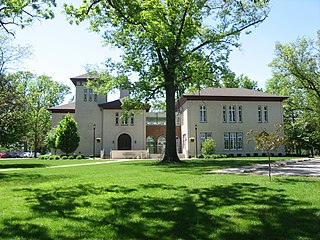
The Urbana College Historic Buildings are a historic district on the campus of Urbana University in Urbana, Ohio, United States. Composed of three nineteenth-century buildings, the district includes the oldest structures on the university's campus.

The Wilson–Lenox House, also known as the "Marvin Ditmer House", is a historic house west of Sidney in Washington Township, Shelby County, Ohio, United States. Built in the Dutch Colonial style, the house was built in the 1810s; it was the first brick house in Shelby County. Sources disagree about its date of construction: some believe that it was built in 1810, while others hold that it was erected in 1816.

The Captain Jonathan Stone House is a historic residence in the city of Belpre, Ohio, United States. Built just ten years after Belpre's 1789 establishment on the north bank of the Ohio River, it is the oldest existing building in the city.

The First Unitarian Church of Marietta is a historic Unitarian Universalist church in the city of Marietta, Ohio, United States. Founded in 1869, it uses a building constructed in 1858 for one of its two predecessor churches; this building's high-quality architecture has led to its designation as a historic site.

The Jamestown Opera House is a historic government building and community center in the village of Jamestown, Ohio, United States. It has been named a historic site because of its well-preserved architecture. Besides serving as a theater, the opera house has functioned as the community's village hall, its fire station, its post office, and its library.
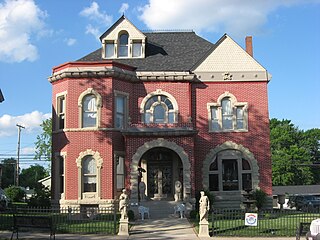
The Oram Nincehelser House is a historic residence in the village of Mechanicsburg, Ohio, United States. Built for a nineteenth-century local doctor, it has been named a historic site because of its distinctive architecture.

The John H. Clark House is a historic residence in the village of Mechanicsburg, Ohio, United States. Built during Mechanicsburg's most prosperous period, it was the home of a prominent local doctor, and it has been named a historic site because of its historic architecture.

The Urbana Woodruff House is a historic house at 1096 East Street in Southington, Connecticut. Built about 1784, it is a well-preserved example of vernacular Georgian architecture. It was listed on the National Register of Historic Places in 1989.

Yost & Packard was an architectural firm based in Columbus, Ohio, United States. The firm included partners Joseph W. Yost and Frank Packard. It was founded in 1892 and continued until Yost moved to New York City in 1899, after which Packard took up practice in his own name.

